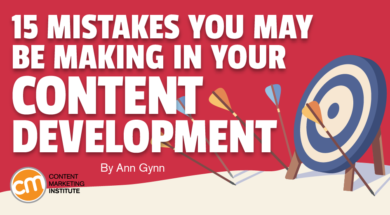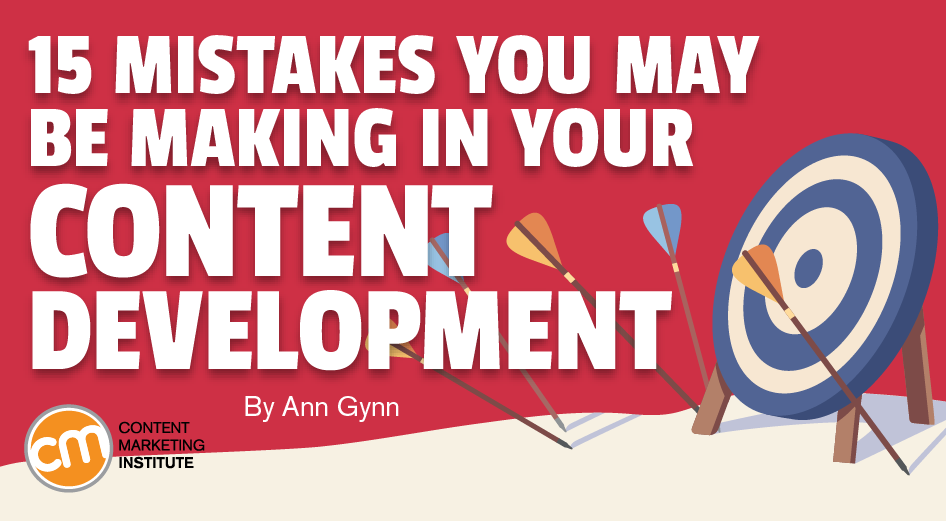
Too often, when content marketers talk mistakes, they’re referring to typos, grammatical errors, and misspellings.
That narrow focus on the granular could be their biggest gaffe.
That’s what we discovered after asking ContentTECH Summit presenters for the biggest mistakes they see happening in the content creation, production, and promotion processes.
How many of these mistakes sound familiar?
1. Don’t know the customer
Failure to fully understand customer needs and wants drives poor and unclear communication – which wastes precious energy and time and serves as a frustration point to customers. This challenge could ultimately have a negative impact on your brand. – Wendy Richardson, senior vice president, customer technical services, Mastercard
2. Stay in the funnel
Getting too stuck in “funnel thinking” instead of serving our audience’s needs with authenticity, agility, and empathy. The COVID-19 pandemic brought this to the forefront. The traditional buyer’s journey became irrelevant for many businesses, but those who responded with empathy and a deep understanding of their personas continued to provide value and build trust throughout the crisis. – Allison Wert, senior marketing strategist, SmartBug Media
Don’t get stuck in “funnel thinking.” Serve your audience needs authentically, says @AllisonWert via @CMIContent. #ContentTECH Click To TweetHANDPICKED RELATED CONTENT:
3. Force the connection
(It) is when a content producer or team thinks that the best customer experience comes from forcing customers to enter through their team’s portal. Self-service is key today. The best self-service happens wherever the customer happens to be. – Megan Gilhooly, vice president of customer experience, Zoomin Software
4. Operate without structure
(It) is not having a defined and ratified strategy that:
- Sets the focus/strategic initiatives that the team(s) will work toward executing
- Clearly defines the governance model that will drive content operations
- Details the goals, KPIs, and metrics that will be tracked to monitor the teams’ progress towards the identified goals.
– Cathy McKnight, vice president of strategy and consulting and chief problem solver, The Content Advisory
5. Do all with one
Having campaigns to address every stage of the customer life cycle can be very daunting. But, having a campaign that is trying to do it all (awareness, growth, loyalty, etc.) isn’t the right answer. Marketers should target their campaigns for specific purposes and specific parts of their customer’s journey. Being more targeted not only helps with clarity in content creation, but it simplifies what KPIs you need to track in order to measure success for the campaign. – Sean Amster, digital marketing manager, Henry Company
Using one #content campaign for awareness, growth, and loyalty isn’t the right answer, says @Sean_Amster via @CMIContent. #ContentTECH Click To Tweet6. Operate in parallel universes
The biggest issue today is fragmenting the brand and wasting huge amounts of resource and time by creating parallel content strategies. The research clearly says that customer experience needs to be seamless and omnichannel.
Content teams need to get to the root of the issue and build structures, governance, models, and strategies that allow teams working in channels, regions, and agencies to have shared standards and repositories to work from. Personas, journeys, taxonomies – share them widely. – Noz Urbina, omnichannel content strategist, Urbina Consulting
7. Fail to get sufficient information
Data, data, data. The biggest mistake is that not enough time is spent acquiring and curating data for the creation of customer and buyer personas, and a strategy for your content. – John Horodyski, managing director, Optimity Advisors
8. Forgo data
Not using enough data is the biggest mistake. Content creators have a tendency to create for themselves instead of their audiences. Find out what the audience really wants first, then craft your content around it. – Christopher Penn, chief data scientist, Trust Insights
Find out what your audience really wants first, then craft your #content around it, says @cspenn via @CMIContent. #ContentTECH Click To Tweet9. Do it by hand
One huge mistake is manually processing the vast amount of data involved across the content life cycle (research, planning, briefing, writing, editing, publishing, optimization, and reporting). The days of handling the data manually are over and content marketers that fail to realize it are facing an uphill battle. – Jeff Coyle, co-founder and chief product officer, MarketMuse
10. Personalize the wrong way
Content personalization has become an imperative for most enterprises … Yet companies struggle to provide personalized content in a scalable way. There are three common mistakes companies make when trying to provide personalized content experiences:
- Starting at the end, rather than the beginning. Most companies focus most or all their attention on content delivery. To deliver personalized experiences at scale, you need to make changes to the way you create the content.
- Throwing new tools at old content. Companies are spending millions of dollars buying new tools. If you throw expensive new tools at the same crappy content, you end up with expensive crappy content. Before buying software, focus on the content and what you need it to do.
- Same silos, new paradigm. Marketing departments often employ multiple vendors to create content, independently working in their own ways. This content can be vastly different. That means you cannot mix-and-match content to provide personalized experiences. Silos also exist among different departments within the enterprise.
To deliver personalized content experiences at scale, you need to focus on the content first. – Val Swisher, CEO, Content Rules Inc.
If you throw expensive new tools at the same crappy #content, you end up with expensive crappy content, says @valswisher via @CMIContent. #ContentTECH Click To Tweet11. Plan for now
Teams often waste time, energy, and resources when they don’t plan ahead at the beginning of the content production process.
You may not anticipate every use case, but if you shoot a video knowing it will also be edited for social media, advertising, and emails, think about how you plan that shoot accordingly. Those are the kinds of decisions that will save you time and money later – no reshoots necessary. – Zontee Hou, co-lead, consulting, Convince & Convert
Teams waste resources when they don’t plan at the beginning of the #content production process, says @ZonteeHou via @CMIContent. #ContentTECH Click To Tweet12. Think about the quick and cheap
Unfortunately, too often content teams prioritize speed and price leading to content that feels cheap or slapped together. This leads to either questioning why the content has fallen flat or relying heavily on paid promotion just to reach engagement goals. Content teams should consider how these priorities conflict and often cost more money in the end.
Today’s audiences have discerning tastes – they are more apt to share content that they perceive to be high quality and content that friends and colleagues would equally engage with than they are to share something that lacks that custom feel.
Content teams should shift their budgets so that more money is spent on custom design and less money is spent on promotion. They’ll find that content with great design and an eye for visual communication will succeed far more (and with far less of a promotional budget) than cheap content that will only be seen with a healthy promotion budget behind it. – Amy Balliet, founder and CEO, Killer Visual Strategies
HANDPICKED RELATED CONTENT:
13. Create just for SEO
Not adding in any user research or adequate content design work before content is created (are the biggest mistakes).
For some reason, many companies are still creating these vapid blog posts designed for SEO, listing fact after fact with no consideration for the user’s actual intent and state of mind. These posts, hidden away on the blog section of a website that no one visits, barely scratch the surface of the useful content a potential customer/client might be looking for. Sometimes they’re written by extremely inexperienced staff, or worse, AI-generated with tons of filler language and decorated with vague stock photography.
If you’re creating content, use the technology at your fingertips to do it justice. Spend time with the writing, the design. Consider how a user might actually want to see the information most helpfully structured. Stop using stock photos and go out of your way to create something custom for the content. An investment in higher quality content means better results down the line, always. – Deborah Carver, consultant, The Content Technologist
Stop using stock photos and go out of your way to create something custom for your #content, says @thecontenttech via @CMIContent. #ContentTECH Click To Tweet
14. Treat accessibility as a value add
Demoting accessibility to a “nice-to-have” feature is a common habit for teams with limited resources expected to deliver more content than ever. If we don’t personally experience content through accessible features, it’s hard to grant them their deserved priority because we don’t observe their impact.
In addition to the numerous humanist reasons for ensuring accessibility, recent court cases have laid uncertain precedent for digital content producers to be held liable under the terms of the Americans with Disabilities Act, reinforcing the legal responsibility we all have to ensure equal access.
Highly accessible content (also) tends to provide significant SEO benefits – after all, a person navigating your site with a screen reader is experiencing your site in much the same way a search engine crawler browses your content. – Andrew Cafourek, founder, Lat Long
Highly accessible #content (also) tends to provide significant #SEO benefits, says @acafourek via @CMIContent. #ContentTECH Click To Tweet
15. Work too quickly and thoughtlessly
Many content teams make the mistake of rushing content creation and production and publishing more content at the expense of quality content. Poor content rarely gets results. Content that increases awareness and inbound traffic fills a knowledge gap, provides value to the audience, and is easy to consume. – Liz Willits, content strategist and marketing consultant, LizWillits.com
Make mistake-free content marketing
Though these 15 mistakes cover a gamut, they can be simplified into a couple overarching themes:
- Focus on the audience.
- Understand the big picture.
- Take the time to do it right.
Pick one area to tackle and fix those elements first, then move on to the next. Soon, you’ll have remedied these problems (and probably have identified a few new ones to address).
What fixes have you found for the mistakes identified here? What other mistakes do you see that hinder content creation, distribution, and promotion? Please share in the comments.
Cover image by Joseph Kalinowski/Content Marketing Institute

